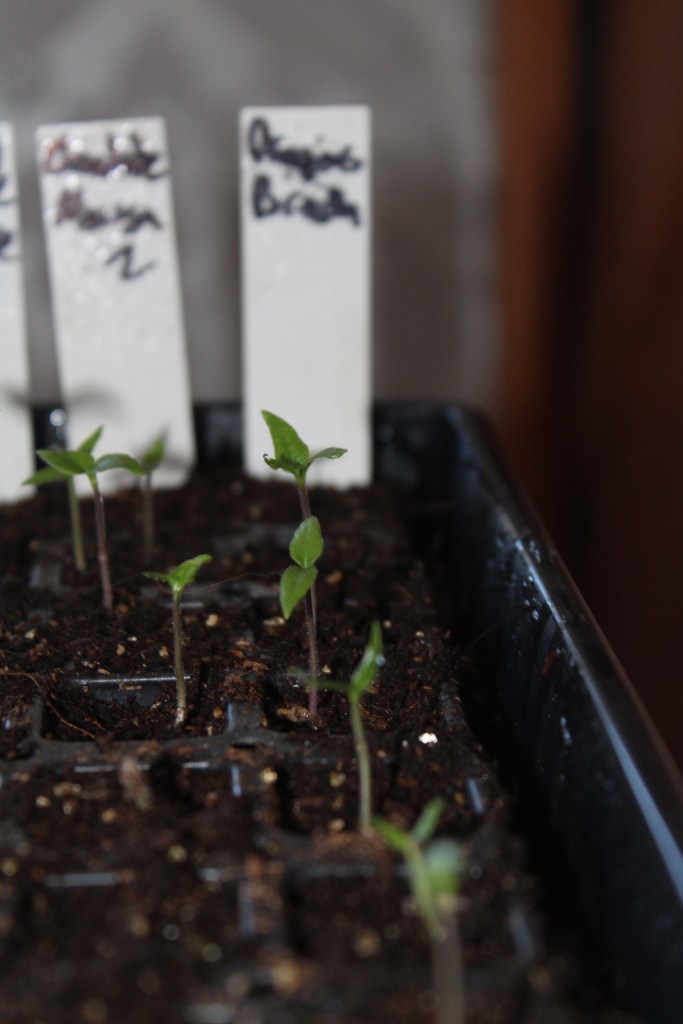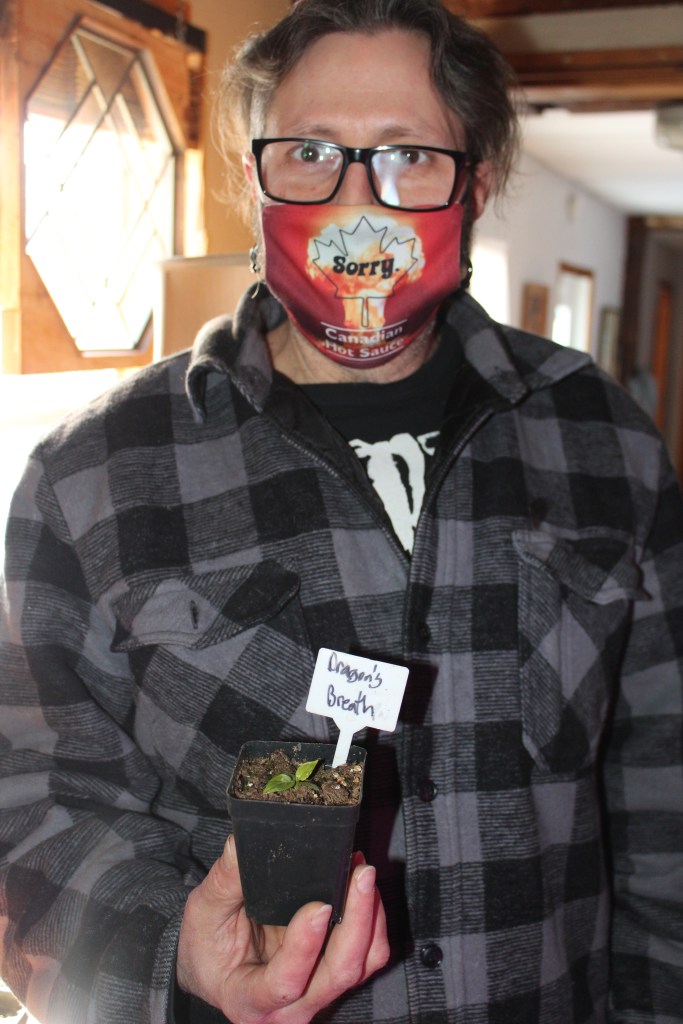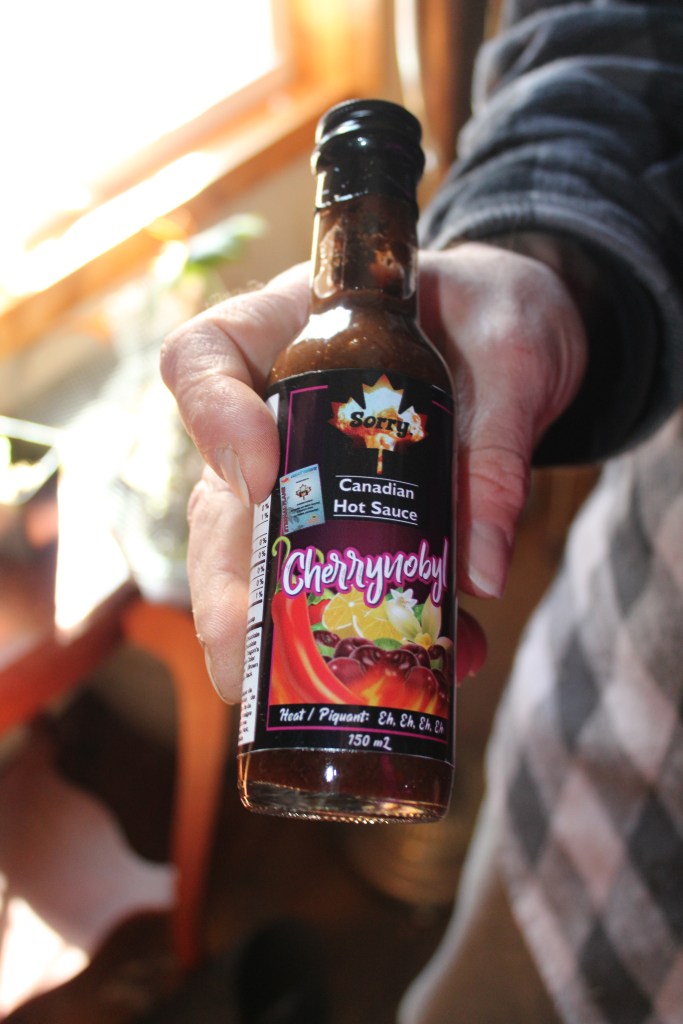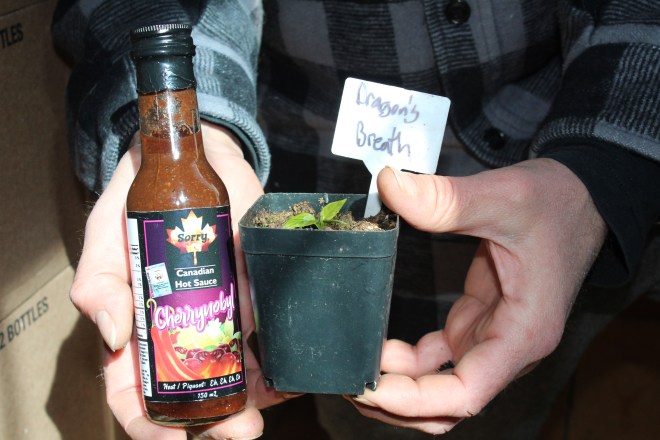This is the first in a series of articles that will follow a Dragon’s Breath pepper plant from seedling to bottles of Sorry Sauce’s Award-Winning Cherrynobyl extreme hot sauce.
In the bowels of the former Lebanon United Church in Mapleton Township, Ontario, the makings of one of Canada’s hottest all-natural sauces have started to take root and flourish. The ground was broken on the church’s construction in 1888, and it was completed in 1897.
“The previous owners told us that it had been deconsecrated in 1971,” said Sorry Sauce creator Erik Begg. “We bought it in 2017.”
The Garden of Apologies has expanded every year since, and the Greenhouse of Extreme Regret was added in 2021. With the pepper supply under control and a few recipes refined to perfection, Sorry Sauce is in full swing.
“I have eight recurring recipes that I have in stock almost all of the time, but the real fun comes with crafting new and unusual hot sauces,” said Begg. “Everyone makes a mango hot sauce, but who else makes a sauce with pawpaw or kohlrabi?
These award-winning, farm-to-table hot sauces are made with local ingredients and green energy.
“It’s Canadian hot sauce, so every bottle comes with a free apology,” he said.
Most peppers have a 120 to 180-day growing cycle, so they don’t have enough time in a Canadian summer to grow outside.
“They also are used to places like Trinidad and Tobago or India and Bangladesh where the temperature tends to be a lot warmer than it is here,” said Begg. “So, they need to be between 18 and 24 degrees Celsius if they are going to germinate.”
To maintain the temperature, he keeps the trays of freshly planted seeds on waterproof heat mats. Begg started his first batch on Jan. 4, and by Feb. 24, he was on his seventh mixed tray of peppers.

“The seeds in nature go through a chemical scarification process where a bird usually eats them and then they are flown somewhere and crapped out,” he said. “The digestive acid in the stomach will break down a bit of the seed to soften it and aid in germination but not enough that it will break the shell entirely.”
Scarification can also be achieved by soaking seeds in black tea to soften them.
“I skip that stage because I often plant in bulk,” said Begg.
He drew attention to a small Dragon’s Breath pepper plant in his grow tent.
“It’s largely circumstantial and unproven, but there are claims out there that it is the new hottest pepper in the world,” he said.
Begg noted that the League of Fire Pepper Eating Championship held in Ottawa at Heating Up the Capital last September used Dragon’s Breath Peppers in the twelfth and final round.
“The thing that corroborates the heat is that Mike Jack is one of the best pepper-eaters in the world,” he said. “He has multiple world records, and he won the contest, but the Dragon’s Breath pepper hurt him.”
Some of the seedlings starting to sprout were a little bit too tall for Begg’s liking.
“They are stretching to get to the light,” he said. “When I transplant them. I will plant them deeper. Nightshades get little hairs down the stem. Eggplants and tomatoes as well. If you plant those, they develop into roots.”

Standard practice is to plant multiple seeds per cell and then cull the ones that are not doing well and keep just the strongest so they don’t compete.
“That said, these are not easy seeds to come by, so rather than sacrificing them, if I have a viable seed, I will pull it out and keep it,” he said. “This year, I’m overplanting, so then I can then supply some of the garden centres. I’ve spun off the Garden of Apologies as its own entity now.”
According to Begg, the springtime brings a lull in hot sauce sales, so making seedlings available through sorrysauce.ca, Kijiji, and a few local retailers starting in April will fill that slow gap.
He showed off the small Dragon’s Breath pepper plant, not much more than a short stem and a few leaves.

“It’s early in the season, so the peppers don’t have to be pristine now,” he said. “They need to be healthy and surviving, and as soon as they hit the garden outside, they tend to explode and take off.”
Begg said he is past the hard part with this plant. It’s in soil, and he had the right mixture of heat and moisture to trigger germination.
“I’m into the first set of true leaves here, so you’ve got the preliminary leaves that come out from the shell and the first set of the new leaves that develop. Once I hit the new leaves stage, I know the plant will be okay.”
He will fertilize and feed the small plant in the grow tent for a few months before it goes outside.
“This will develop a really good root ball,” he said. “There’s a difference in consensus on it. A lot of pepper growers dislike the root ball because they think that it will stunt the plant … and doesn’t respond well when it gets outside, so they may start things later.”
Begg likes to plant early, so he has a chance to recover if he messes something up.
“Having an excellent root ball allows a lot of carbohydrate energy to be stored up in the plant, so when I put it into the ground, it will take it a week or two to figure out that the roots now have some room to grow and then the plant takes off,” he said. “So, all the growth happens underground for a couple of weeks, and it doesn’t look like anything is happening, and then suddenly your plant is a metre high and covered in flowers.”
Cherrynobyl, the sauce that this Dragon’s Breath pepper plant will be producing peppers for, garnered Begg his first award for a Sorry Sauce.

“It was right at the start of the pandemic, so it was a turning for the entire business, for my entire life,” he said. “Feb. 29, 2020, at the Heatwave Expo, I won best extreme sauce. That was a bit of a validation for me because I was, at that point, still a guy making hot sauce as a fun hobby. This was the revelation of – hey, wait a minute, if I have the best of the show, maybe it is better than I thought it was.”
He describes Cherrynobyl as “a careful balance between delicious and utterly terrifying. The base of Niagara black cherries, black cocoa, vanilla bean with elements of lemon, black pepper and brown sugar is as delicious as it sounds, but then I add a whole bunch of peppers. The current batch uses a blend of the hottest peppers in the world with red, yellow and chocolate Carolina Reapers with chocolate Bhutlah and Dragon’s Breath peppers for a fire that tastes like an accidental core meltdown.”
Begg has been making a claim this year, which he says no one has successfully challenged, “that it’s the hottest all-natural sauce made in Canada.”
The next installment of this series will follow the plant from the grow tent into the ground on its way to producing peppers for a scorching sauce.
Consider supporting wood-stein.ca to keep the ideas flowing! Become a Patron!


One thought on “From seedling to sauce, the life of a Dragon’s Breath pepper plant Part 1”